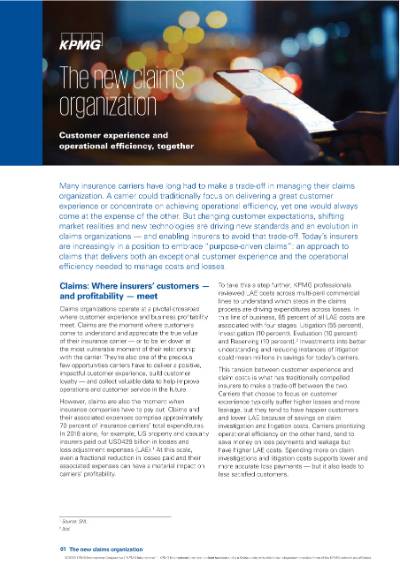Many Insurance carriers have long had to make a trade-off in managing their claims organization. A carrier could traditionally focus on delivering a great customer experience or concentrate on achieving operational efficiency, yet one would always come at the expense of the other. But changing customer expectations, shifting market realities and new technologies are driving new standards and an evolution in claims organizations — and enabling insurers to avoid that trade-off. Today's insurers are increasingly in a position to embrace “purpose-driven claims”: an approach to claims that delivers both an exceptional customer experience and the operational efficiency needed to manage costs and losses.
Claims: Where insurers' customers — and profitability — meet
Claims organizations operate at a pivotal crossroads where customer experience and business profitability meet. Claims are the moment where customers come to understand and appreciate the true value of their insurance carrier - or to be let down at the most vulnerable moment of their relationship with the carrier. They're also one of the precious few opportunities carriers have to deliver a positive, impactful customer experience, build customer loyalty — and collect valuable data to help improve operations and customer service in the future.
However, claims are also the moment when insurance companies have to pay out. Claims and their associated expenses comprise approximately 70 percent of insurance carriers' total expenditures. In 2018 alone, for example, US property and casualty insurers paid out US$428 billion in losses and loss adjustment expenses (LAE)1. At this scale, even a fractional reduction in losses paid and their associated expenses can have a material impact on carriers' profitability.
To take this a step further, KPMG professionals reviewed LAE costs across multi-peril commercial lines to understand which steps in the claims process are driving expenditures across losses. In this line of business, 85 percent of all LAE costs are associated with four stages: Litigation (55%), Investigation (10%), Evaluation (10%) and Reserving (10%)2. Investments into better understanding and reducing instances of litigation could mean millions in savings for today's carriers.
This tension between customer experience and claim costs is what has traditionally compelled insurers to make a trade-off between the two. Carriers that choose to focus on customer typically experience higher losses and more leakage, but they tend to have happier customers and lower LAE because of savings on claim investigation and litigation costs. Carriers prioritizing operational efficiency, on the other hand, tend to save money on loss payments and leakage but have higher LAE costs. Spending more on claim investigation and litigation costs supports lower and more accurate loss payments — but it also leads to less satisfied customers.
Stay up to date with what matters to you
Gain access to personalized content based on your interests by signing up today
Connect with us
- Find office locations kpmg.findOfficeLocations
- kpmg.emailUs
- Social media @ KPMG kpmg.socialMedia

A changing world requires new thinking about insurance claims
But this traditional tension between customer experience and claim costs — and the trade-offs that result — may soon be a thing of the past, as several trends converge to spark an evolution in the claims space.
- Customer expectations are rising and changing fast, driven by customers' online experiences with banks, retailers and other businesses outside the insurance sector. Today's customers expect seamless digital experiences — and they expect those they do business with to understand them and deliver products and services tailored to their needs.
- Market efficiencies have shifted. In several areas of the market, losses have outpaced premium growth for multiple years and in some product lines, claims have grown more frequent and severe. As a result, carriers are facing pressure to become more efficient and cut operational costs.
- Technology and innovation are changing the world of insurance. Tech giants and nimble insurtech companies are introducing solutions to fundamentally alter the landscape, from modular infrastructure and advanced analytics to new data sources and automated operations.
Forward-thinking insurers are seizing on these new tools and technologies as a way to rethink how the claims organization operates and deliver the experience and efficiency that customers and the market demand. Embracing a more balanced, “purpose-driven” claims approach enables carries to provide differentiated value to customers through exceptional experiences. At the same time, purpose-driven claims creates value for the organization itself though highly efficient, data-driven operations that integrate throughout the claims function and the rest of the enterprise.
Ample opportunity to enhance the entire claim value chain
To date, insurance carriers' efforts to rethink and reinvent the claims process have mainly focused on the front end of that process, particularly first notice of loss (FNOL). More and more carriers now allow customers to submit claims and supporting evidence online or via mobile devices, for example. Yet while carriers' FNOL experience is up-to-the-minute, the rest of the claims value chain is often stuck decades behind, causing friction in customer experience and driving expenses across the claims process
Clearly, there's ample opportunity for insurance carriers to upgrade and improve their claims organization across the value chain using some of the many tools and solutions that have emerged in recent years. Here are some examples:
- Prevention: Data-driven insights can enable insurers to identify emerging claim risks — as well as those that are receding --and make necessary adjustments based on projected future loss trends. Carriers can harness third-party data and connected devices to provide tailored risk coverage and preventative communications that can help prevent or mitigate losses. Hyperlocal weather data can be used to push notifications to insured customers to take action in the event of an imminent storm or severe weather event.
- FNOL: Insurers are putting digital tools in the hands of customers, providing seamless submission processes and collecting valuable data in the process. Others are using new tools to identify claims before they are submitted, and at times before a customer knows that they have happened, through using sensors in homes and commercial properties to detect water leaks or flooding or aerial imagery immediately following natural disasters in order to identify damaged or destroyed insured property.
- Assignment: Insurers can use historical data and new data sources to make smarter, faster decisions about claim severity and complexity to properly assign incoming claims to human processors and adjusters or automated, straight-through processing tools as necessary. Harnessing data in this way can help avoid the risk of claim reassignment, which slows the customer experience and increases costs.
- Investigation and evaluation: With digital claim submissions and third-party data, carriers can rapidly assess claims, determine repair or replacement costs, and detect potential fraudulent behaviour such as claim inflation.
- Reserves: Leveraging current claim data and predicted loss trends can enable carriers to rapidly adjust their reserve levels more accurately, efficiently — and frequently — than ever before. Instead of adjusting reserves on a scheduled basis, carriers can instead update reserves in near real-time, which helps maximize the capital available for investment elsewhere.
- Litigation: Traditionally, carriers would hand claim-related cases to trusted local counsel in a given jurisdiction. Today, carriers can use data analytics to predict the likelihood of claim litigation and its outcome — and offer payments to forestall the case. Should the case proceed, carriers can use the same tools to predict the outcome based on the attorneys, judge, court or jurisdiction, and plan accordingly.
- Payments: Carriers are partnering with claims processors to expedite digital payments to customers. Harnessing sensor and third-party data can take this to a new level, especially in the area of parametric insurance. For example: if a sensor detects an inch or two of water in a basement — or weather data reveals crop losses are likely — the system can automatically trigger a claim event and issue an immediate payment.
- Closure: Seamless data sharing between claims and other business units can help carriers make smarter decisions. Data sharing can help underwriting better understand where losses are emerging, how risks are changing and how underwriting rules need to be adjusted. It can help product development understand new product opportunities, by analyzing uninsured losses to identify product portfolio gaps and exploring the implications of changing risks.
- Recovery: Sensors, camera footage, drones and other technologies can all be used to help carriers recover some or all of their losses once they've paid a customer's claim. Careful data analysis can help determine who's truly at fault for a given claim and shore up recovery efforts. Claim data can also be used to help carriers refine their underwriting process and product portfolio — and even identify new product opportunities.

To build a purpose-driven claims organization, first ask who you want to be
Before launching an effort to become a purpose-driven claims organization, it's vital that carriers reflect on who they are today — and who they want to be. While the purpose-driven claims organization can enable carriers to deliver both outstanding customer experience and operational efficiencies, many carriers may still choose to emphasize one more than the other. How a carrier prioritizes these efforts may result in accumulating advantages that deeply differentiates its offering from its competitors over time.
Carriers that choose to focus on operational efficiency may opt to retain ownership of operations and outsource or partner to deliver a superior customer experience. Those that decide to go all in on customer experience, conversely, may look for another organization to handle operations matters on their behalf. Carriers' own internal capabilities — and desire or capacity to invest — inevitably help shape such decisions as well.
In our KPMG member firm experience, the carriers making the best use of data and the new technologies available to them are those who know what they want to be and who have a clear understanding of what parts of the business they must own, what they can deliver through partnerships, and which solutions they can integrate to build best-in-class operations.
It's time to evolve claims
As the customer experience becomes a strategic imperative for carriers, the claims organization will play an even larger role in helping define customer sentiment and brand loyalty, thereby helping to determine the carrier's future success and destiny. Insurance carriers and their claims organizations no longer need to sacrifice customer experience for operational efficiency, and vice versa. Leveraging data, implementing new technologies, and designing thoughtful future looking processes and architecture can enable carriers to balance both goals in a way that aligns with their overall strategy and vision. The solutions are available today, but require a new mindset and dedication to move the needle - are you ready?
Footnotes
1SNL.
2Ibid



